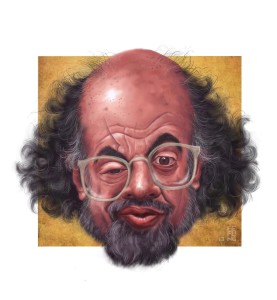 Allen Ginsberg
Allen Ginsberg
by Steve Finbow
Reaktion Books. 237 pages, $16.95
SO MANY literary biographies these days are massive tomes that reviewers have stopped referring to them as doorstops. But more condensed biographies can also be found, and they come with their own challenges. If the book is to be kept under 300 pages, what should be included and what left out, how much space can be given to discussing the significance of events or analysis of the writer’s work? Steve Finbow has written a brief biography of Allen Ginsberg as part of the Critical Lives series published in England. Although not a complete success, it presents this important poet’s life in a manageable length.
 Although troubled by his homosexuality, the young Ginsberg declared his love for the hypermasculine Kerouac and Cassady, and he managed to have sex with both of them. Finbow believes Ginsberg had a masochistic attraction to straight men throughout his life. In the case of Kerouac, Ginsberg also helped get his first book, The Town and the City (1950), published. Ginsberg’s own first book, Howl and Other Poems (1956), was published in 1956 and had to be defended in court against a charge of obscenity. This was the beginning of the author’s defiance of the cultural and political norms of his day. By then, Ginsberg was more comfortable with his sexuality, playfully ending one poem with the famous line, “America I’m putting my queer shoulder to the wheel.” Although he never found the lover he longed for, the celebration of sexuality in all its forms became a major component of Ginsberg’s poetry.
Although troubled by his homosexuality, the young Ginsberg declared his love for the hypermasculine Kerouac and Cassady, and he managed to have sex with both of them. Finbow believes Ginsberg had a masochistic attraction to straight men throughout his life. In the case of Kerouac, Ginsberg also helped get his first book, The Town and the City (1950), published. Ginsberg’s own first book, Howl and Other Poems (1956), was published in 1956 and had to be defended in court against a charge of obscenity. This was the beginning of the author’s defiance of the cultural and political norms of his day. By then, Ginsberg was more comfortable with his sexuality, playfully ending one poem with the famous line, “America I’m putting my queer shoulder to the wheel.” Although he never found the lover he longed for, the celebration of sexuality in all its forms became a major component of Ginsberg’s poetry.
Ginsberg’s early years in New York, San Francisco, Tangiers, and Paris, full of the legendary events and mythic figures of the Beat movement, make for engrossing reading. By the end of the fifties he had met Peter Orlovsky, a young, attractive, and primarily straight poet. The two became life partners, although their relationship was fraught due to Orlovsky’s schizophrenia and alcoholism. Madness is the subject of Ginsberg’s 1958 masterpiece, “Kaddish,” a long lament written after the death of his mentally ill mother Naomi. Finbow speculates that the frenetic pace of Ginsberg’s life as he became more and more famous was a sign of bipolar disorder.
In 1965, Bob Dylan introduced Ginsberg to the Beatles in London, enabling him to become the link between the Beats and the hippies. A tone of censure enters Finbow’s writing when Ginsberg starts to spend time with celebrities and earn money by giving poetry readings. Fewer and fewer new poems get written, although awards and literary prizes come Ginsberg’s way in his later years. Finbow sees the political Ginsberg as a betrayal of the poet. To say Ginsberg traded poetry for protest is to miss the fact that he was an activist throughout his life, whether he was taking care of his troubled friends, helping other writers to get published, or marching in Chicago.
In the introduction, Finbow states that he wrote this biography without first establishing a theoretical position with which to approach Ginsberg. He also decided that he would reference other writers and cultural signposts as they occurred to him while he wrote. As a result, the book has a disjointed quality. Events from Ginsberg’s early life are included, often in scattered fashion, simply because they appeared in poems, not because they are part of a coherent narrative. Relating the later years, when the poems were scarce, the book becomes merely an account of Ginsberg’s travel from place to place. There is little sense of what Ginsberg was like as he taught classes, read in public, or took part in demonstrations with other writers. At this point the book does not need to be longer. Rather, the author needs to focus on representative incidents that will make his subject come alive for the reader. But for that, he must know what Ginsberg represents, and it is not clear whether this is something that Finbow fully understands.
Daniel Burr is an assistant dean at the University of Cincinnati College of Medicine, where he teaches in the medical humanities program.






